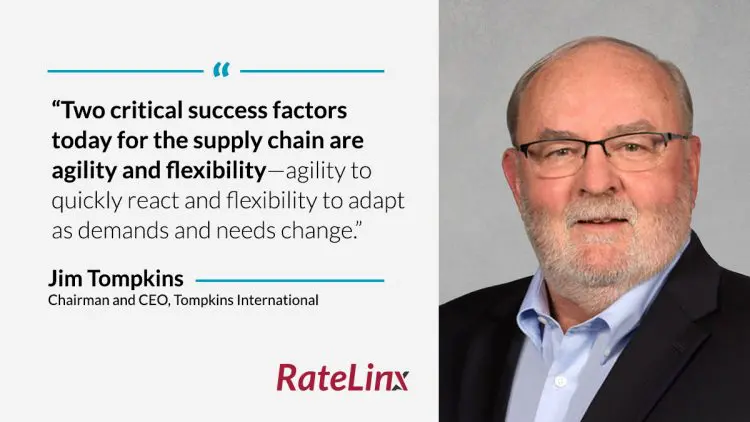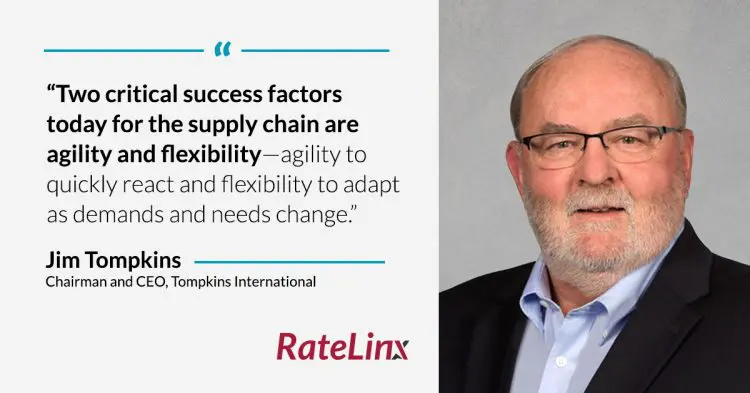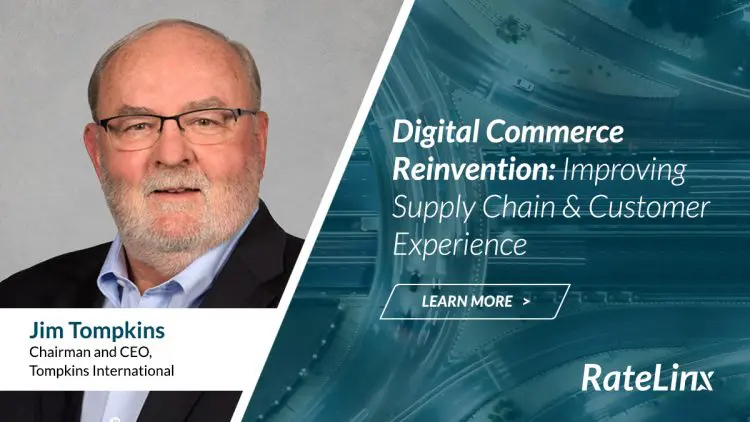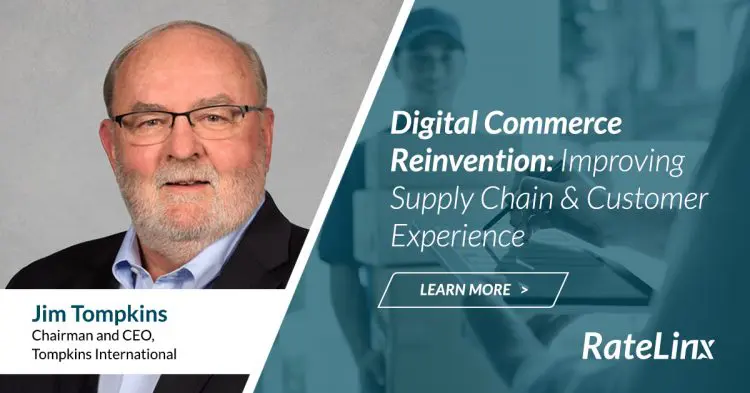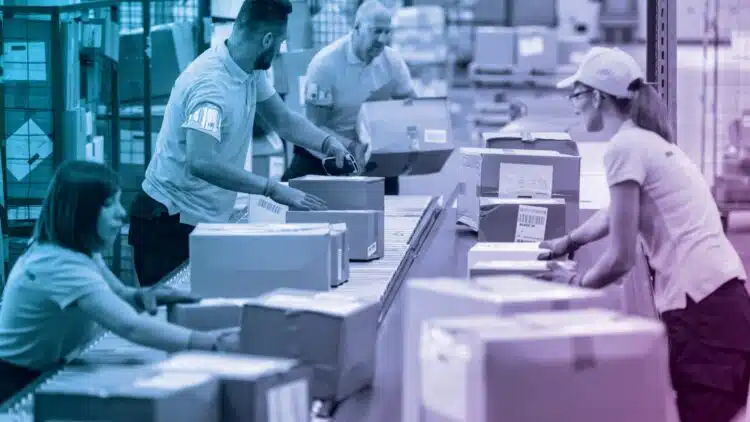“Think outside the box” may be the most tired cliche in the history of business writing. The problem is, it’s still relevant to the way most businesses are organized. We tend to think and act in boxes.
There’s a box for customer service, one for marketing and sales, procurement, supply chain—you get the idea. Each department does the best they can, but misses out on opportunities to improve the business as a whole.
The future of success in business depends on not just thinking outside the box but breaking down artificial barriers. It depends on seeing the organization as a whole, using data from every department to maximize efficiency and deliver for customers.
Author, speaker, and consultant Jim Tompkins is dedicated to helping businesses reorganize to meet modern consumer demands. For example, he focuses on how to integrate the supply chain with the customer journey to promote sustainable, profitable growth.
Jim shared his advice on supply chain transformation, customer experience, and more in our recent interview. You can find out more about Jim and other great supply chain experts to follow here.
Featured Expert

Jim Tompkins
An expert in global supply chain, logistics, material handling, and business strategy, Jim has over 44 years of experience in the industry. He holds a PhD from Purdue University and has received the Frank and Lillian Gilbreth Industrial Engineering Award.
Why Supply Chain Matters to the Customer Journey
In a sense, everything a business does is part of the customer experience. Follow any internal process far enough, and you can see how it ties back to the customer. To start with, we need to think of the supply chain customer experience as broader than a point of purchase or a pre-purchase journey.
“The customer experience (CX) today involves the entire shopping journey (or buying process),” Jim says. “Each transaction starts with ‘thinking’ and ends with ‘receiving’ or ‘returning.’”
Throughout the purchase process, businesses need to continually meet customers’ emotional needs as well as their physical ones. “The six consumer needs, as identified by Google, include: Surprise Me, Help Me, Reassure Me, Educate Me, Impress Me and Thrill Me,” Jim says.
Fulfilling these emotional requirements takes a whole organization, not just customer service. “Most of these, if not all, require supply chain involvement along the journey, combined with other corporate units,” Jim observes. “Supply chain is a critical success factor throughout the customer journey because product availability, delivery times, and service quality are all highly valuable to customers.”
The internal, behind-the-scenes processes in your business result in delivering a high-quality product. And delivering it to the right customer at the right time. Your supply chain is affecting customer experience for good or ill already, so it’s crucial to make CX part of your strategy.
Add Customer Experience to Your Supply Chain Strategy
Exceptional experience has become an expectation for modern consumers. “The supply chain must do more than stock and ship products. Today’s customers expect the logistics behind their orders to be flawless,” Jim says. “Both the order and return processes must be as seamless as possible and available when, where, and how the customer wants. They depend on the seller to meet—and even anticipate—their needs.”
Much of a business’ capability to meet and exceed consumer expectations comes from strategic optimization of the supply chain. “Delivering an amazing CX requires the supply chain to prepare, operate and delight the customer at every touchpoint throughout that entire journey. This is enabled by the collaboration of demand-supply planning and management,” Jim says. “Two critical success factors today for the supply chain are agility and flexibility. Agility to react quickly and flexibility to adapt as demands and needs change.”
“Digital commerce reinvention requires that the right strategies, people, processes, and technologies all be in place to deliver both sales and operating margins.”
But it’s not just about optimizing the supply chain. It’s about bringing the organization together to create a more comprehensive approach. Jim says, “Profitable growth in the digital commerce era requires new strategies—ones that respond to the changing customer behaviors by understanding the entire shopping journey, providing a strong CX and personalization and knowing what makes each category of customers buy their products.”
This type of holistic strategy requires cooperation between departments that may be unaccustomed to working together. “Marketing and supply chains are increasing their interaction and interdependence; thus, marketing and supply chain strategies are coalescing and must be developed collectively,” Jim says. “What products and services are offered to customers are enabled by the supply chain in many different ways. Customer loyalty—which all sellers want—is determined mostly by supply chain actions.”
Enhance Capabilities with Supply Chain Technology
It takes an unprecedented level of collaboration — and the ability to share data across the business — to create a CX-enabling supply chain strategy. Fortunately, companies have more tools now than ever before to make it happen.
“Technology today plays a highly important role, as supply chains must react faster, increase delivery speed, and focus on customer needs and wants more than ever before. Digital commerce reinvention—not just supply chain—requires that the right strategies, people, processes, and technologies all be in place to deliver both sales and operating margins,” Jim says.
Successful businesses use multiple new technologies in sync with each other to improve customer experience and optimize the supply chain. “Artificial intelligence and machine learning help us understand the ‘why’ and not just the ‘who, what, when and where,’” Jim says. Technology can help bridge the gap between data and physical goods and services as well. “Information technologies help us manage multiple channels and facilities, while the physical technologies—automation, robotics, and IoT—all transform the distribution centers (DCs) to fulfillment centers (FCs) to help us manage order processing,” Jim says.
Like what you’re reading?
How to Get Started
How can businesses start creating an outside-the-box supply chain? A massive supply chain “transformation” may not be the best place to begin. Jim says, “Most companies are starting with supply chain transformations. The problem, however, is that these are becoming ‘stuck’ as leaders are unsure about their objectives and designs for their future state. Digital commerce reinvention is the real need—enterprise-wide, among several departments or units,” Jim says.
Instead, Jim recommends focusing on how your supply chain can boost customer experience to rack up quick wins. “Delivery speed, order turnaround times, flawless returns, and the logistics for each of these can be improved faster than a thorough transformation,” Jim says.
Unbox Your Supply Chain
CX is the crucial differentiator in modern business, and the supply chain is a crucial component for driving exceptional experiences. A great supply chain strategy requires a holistic view of the organization, enabled by technology and enacted by strong leadership. The only boxes in your supply chain strategy should be the cardboard kind.
Learn how to leverage technology to improve customer experience.
What Every Supply Chain Pro Needs to Know About Visibility
Visibility is supposed to answer the question, “Where’s my freight?” but does it? We outline three truths of visibility you need to know.
